NGR 5141
University of Central Florida
All 10 results
Sort by
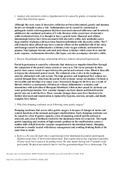
-
NGR 5141 - Module 5 Questions and Answers (2022 2023) (Verified Answers).
- Exam (elaborations) • 7 pages • 2023
-
- $9.49
- + learn more
1. Analyze why ulcerative colitis is hypothesized to be caused by genetic or immune factors rather than infectious agents. Although the exact cause of ulcerative colitis has not been determined, genetic and immune factors are thought to play a role. Inflammation can be caused by commensal or pathogenic enteric microorganisms that have increased mucosal adherence and invasion in addition to the continued activation of T cells. Because of the occurrence of ulcerative colitis in identical twi...
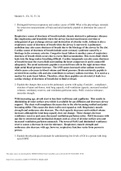
-
NGR 5141 - Module 6 Questions and Answers (2022 2023) (Verified Answers).
- Exam (elaborations) • 5 pages • 2023
-
- $9.49
- + learn more
Module 6 - Ch. 32, 33, 34 1. Distinguish between respiratory and cardiac causes of SOB. What is the physiologic rationale for serum test measurements of brain and atrial natriuetic peptide to determine the cause of SOB? Respiratory causes of shortness of breath include chronic obstructive pulmonary diseases like emphysema and bronchitis where the airway has increased mucus secretion or enlargement of gas exchange airways and destruction of alveolar walls. Asthma is also a respiratory caus...
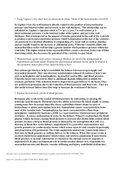
-
NGR 5141 - Module 7 QUESTIONS AND ANSWERS. Questions and Answers (2022 2023) (Verified Answers).
- Exam (elaborations) • 5 pages • 2023
-
- $9.49
- + learn more
1. Using Laplace’s law, show how an aneurysm develops. Think of the hemodynamics involved In Laplace’s law, the wall tension is directly related to the product of intraventricular pressure and internal radius and inversely to the wall thickness. The relationship can be calculated by Laplace’s equation which is T = (p x r)/ µm. T is wall tension, p is intraventricular pressure, r is the internal radius of the sphere, and µm is the wall thickness. This is interpreted as the amount of ...
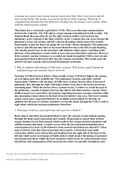
-
NGR 5141 - Module 8 QUESTIONS AND ANSWERS. LATEST 2023
- Exam (elaborations) • 3 pages • 2023
-
- $9.49
- + learn more
A neonate has a harsh, loud, systolic murmur shortly after birth. This is best heard at the left lower sternal border. The neonate is acyanotic and has no other symptoms. What type of congenital heart disorder does this infant have? Explain why the neonate is not cyanotic. When could the infant become cyanotic? This infant has a ventricular septal defect (VSD). This is an abnormal communication between the ventricles. The VSD allows a large amount of shunting from left to right. The shunte...
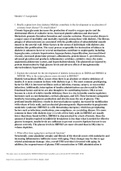
-
NGR 5141 Module 13 Assignment QUESTIONS AND ANSWERS. LATEST 2023
- Case • 5 pages • 2023
-
- $8.49
- + learn more
Module 13 Assignment 1. Briefly explain how does diabetes Mellitus contribute to the development or acceleration of coronary heart disease? To renal failure? Chronic hyperglycemia increases the production of reactive oxygen species and the detrimental effects of oxidative stress. Increased platelet adhesion and decreased fibrinolysis promote thrombus formation and vascular occlusion. Macrovascular disease is a major cause of morbidity and mortality especially among those with diabetes. The...
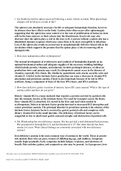
-
NGR 5141 - Module 14 QUESTIONS AND ANSWERS. LATEST 2023
- Exam (elaborations) • 7 pages • 2023
-
- $9.49
- + learn more
1. Joe Smith has had his spleen removed following a motor vehicle accident. What physiologic changes will develop as a result of this? The spleen is not absolutely necessary for life or adequate hematologic function, however, its absence does have effects on the body. Leukocytosis often occurs after splenomegaly suggesting that the spleen has some control over the rate of proliferation of leukocyte stem cells in the bone marrow or their release into the bloodstream. Iron levels may also de...
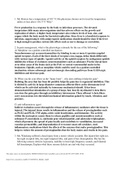
-
University of Central Florida NGR 5141 - Module 11 QUESTIONS AND ANSWERS. LATEST 2023
- Exam (elaborations) • 6 pages • 2023
-
- $9.49
- + learn more
1. Mr. Bowers has a temperature of 101° F. His physician chooses not to treat the temperature unless it rises above 101.5° F. Why? Fever production is a response by the body to infectious processes. The elevated temperature kills many microorganisms and has adverse effects on the growth and replication of others. A higher body temperature also reduces levels of iron, zinc, and copper which the body needs for bacterial replication. Since fever is a beneficial response to infection, suppre...
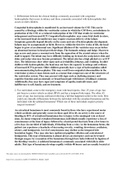
-
University of Central Florida NGR 5141/ NGR 5141 5141 - Module 12
- Exam (elaborations) • 8 pages • 2023
-
- $9.49
- + learn more
1. Differentiate between the clinical findings commonly associated with congenital hydrocephalus that occurs in infancy and those commonly associated with hydrocephalus that occurs in older children. Congenital hydrocephalus is manifested by an increased volume for CSF. This can be caused by a blockage within the ventricular system in which the CSF flows, an imbalance in production of the CSF, or a reduced reabsorption of the CSF that results in ventricular enlargement and increased ICP. C...
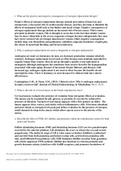
-
University of Central Florida NGR 5141 - Module 9
- Exam (elaborations) • 7 pages • 2023
-
- $9.49
- + learn more
1. What are the positive and negative consequences of estrogen replacement therapy? Positive effects of estrogen replacement therapy include prevention of bone loss and osteoporosis, a decreased risk of cardiovascular disease, and they also help to diminish the effects of menopause itself such as hot flashes and mood swings. Negative consequences of estrogen replacement therapy include an increased risk of breast cancer. This is more prevalent in slender women. This is thought to occur due ...
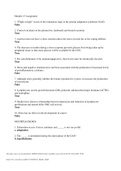
-
NGR 5141/5141 - Module 15 QUESTIONS AND ANSWERS. LATEST 2023
- Exam (elaborations) • 3 pages • 2023
-
- $9.49
- + learn more
1. “Flight or fight” occurs in the exhaustion stage in the general adaptation syndrome (GAS). False 2. Cortisol circulates in the plasma free (unbound) and bound to protein. True 3. A person does not have a stress reaction unless the stress exceeds his or her coping abilities. True 4. The decrease in insulin during a stress response prevents glucose from being taken up by peripheral tissue so that more glucose will be available for the CNS. True 5. For catecholamines to be immunosup...

$6.50 for your textbook summary multiplied by 100 fellow students... Do the math: that's a lot of money! Don't be a thief of your own wallet and start uploading yours now. Discover all about earning on Stuvia


